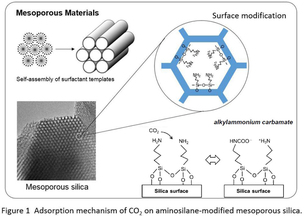- Home
- Development Themes : Amine-modified mesoporous materials
Development Themes
Amine-modified mesoporous materials
RITE has developed a steam-resistant solid sorbent by grafting amino groups onto the surface of mesoporous silica. Mesoporous materials exhibit larger pore diameters (2-50 nm) and greater pore volumes than the microporous materials that are often used for gas capture and separation, allowing the size and amount of grafted amines to be tunable over a wide range (Figure 1). This solid sorbent is able to simplify the CO2 capture process and reduce the associated energy demands due to its steam resistance. Furthermore, reduced amine losses and improved ease of handling are also expected by immobilization of the amine on the solid support.
Solid supports may have a variety of chemical compositions, pore morphologies and surface functional groups. The associated range of designs thus allows the synthesis of novel materials for CO2 capture with high adsorption/desorption performance. RITE has found that a solid sorbent with densely grafted amine groups exhibits high CO2 adsorption performance under wet conditions. This is possible because the formation of carbamates (R2NCOO−) by reaction of amine groups and CO2 is not affected by moisture above 60 °C. As an example, the absorbent triamine-grafted MSU-H (TA/MSUH) shows CO2 adsorption performance under wet conditions similar to that of Zeolite 13X under dry conditions. This property could allow omission of the dehumidification process typically required prior to CO2 absorption, resulting in a reduction in the size of the process equipment. Recently, we have also investigated the application of this material to life support in space.
Click images to enlarge.



